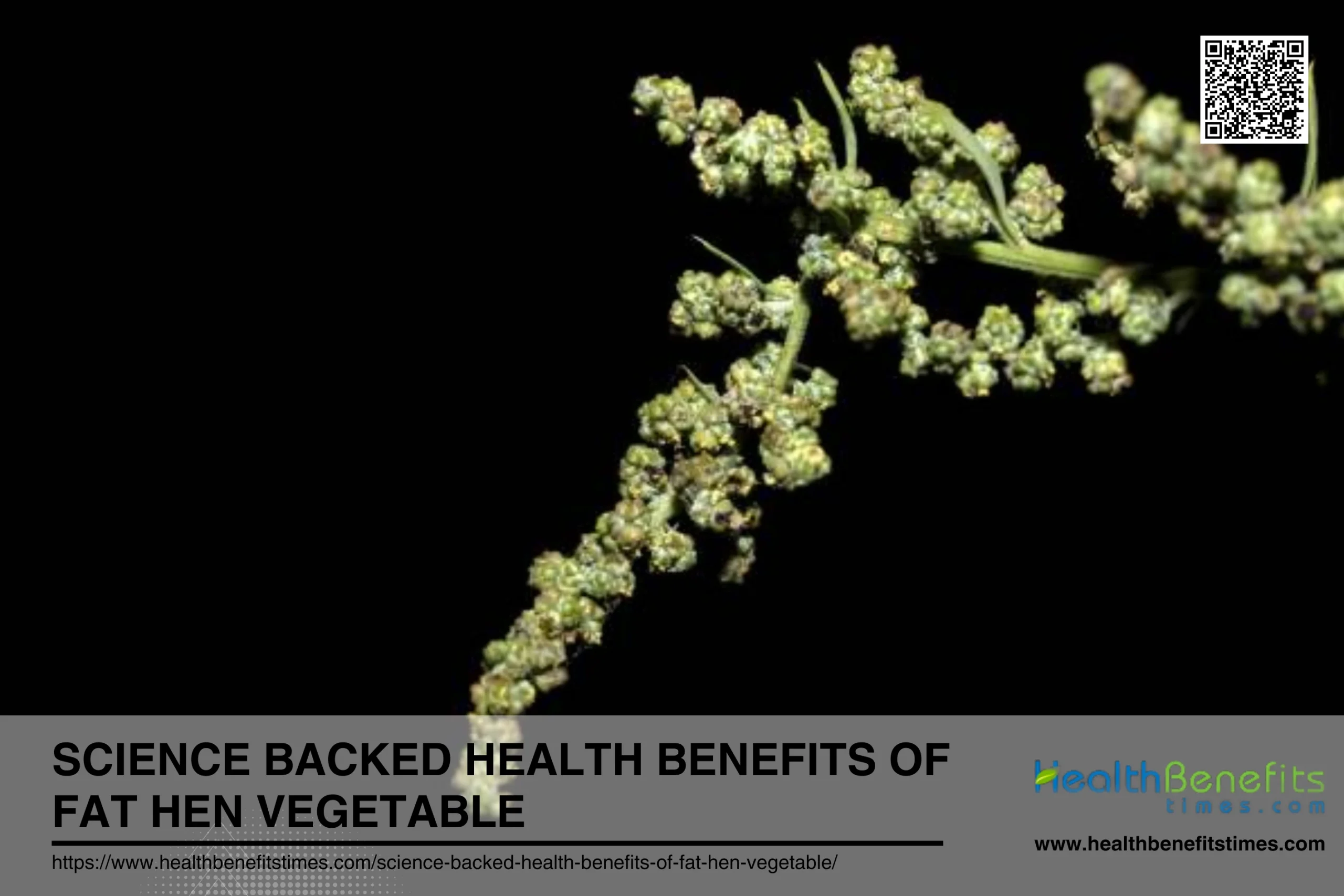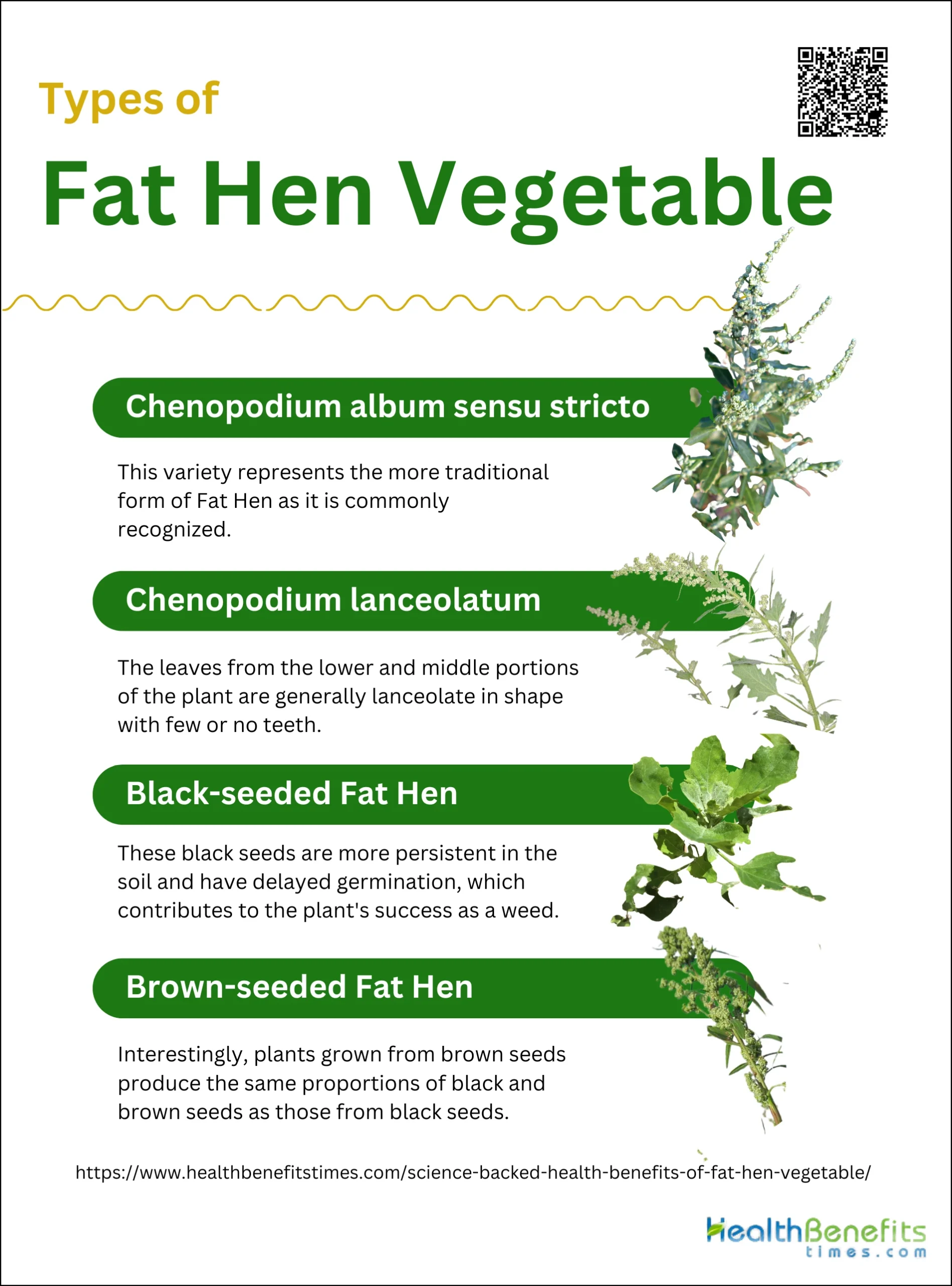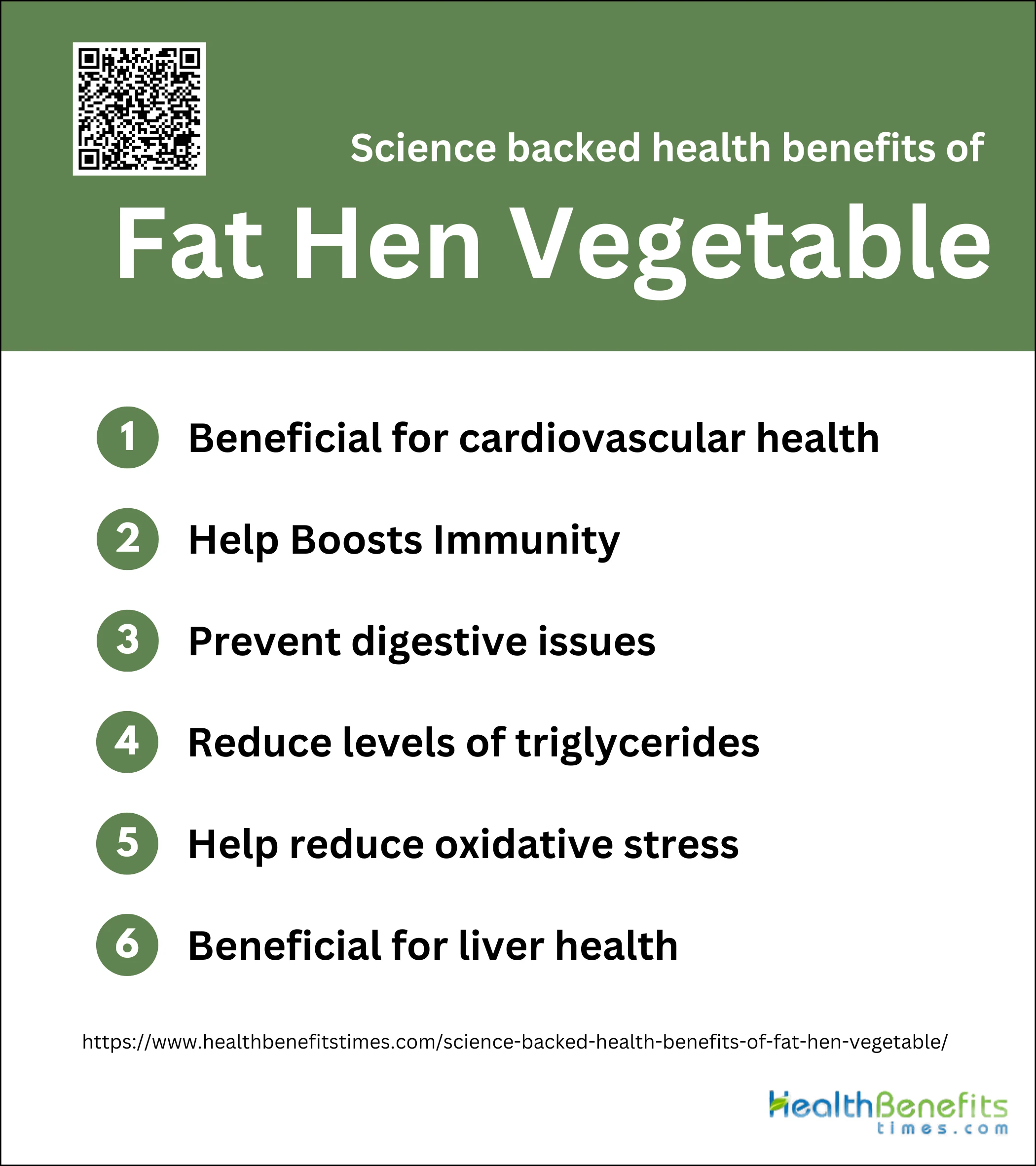- Fat Hen is a nutrient-rich, vitamins A, C, K; minerals, antioxidants, protein.
- Limited information on distinct Fat Hen varieties sensu stricto, lanceolatum, black-seeded, brown-seeded.
- Fat Hen (Chenopodium album) is nutritious, boosting immunity, heart, and digestion.
- Fat Hen reduces triglycerides, oxidative stress, and supports liver health.
- Fat Hen, is a nutritious weed, used historically for medicinal benefits.
- Fat Hen is nutritious, versatile, consider oxalates, nitrates, allergies, and moderation.
 Fat Hen, also known as Chenopodium album, is a remarkable yet often overlooked wild vegetable that boasts a plethora of health benefits backed by science. Despite its reputation as a common weed, Fat Hen is a nutritional powerhouse, rich in essential vitamins, minerals, and antioxidants. This resilient plant, which is closely related to spinach and quinoa, offers a range of health benefits including anti-inflammatory properties, digestive support, and potential wound healing capabilities. Its leaves and seeds are packed with nutrients such as vitamin A, vitamin C, calcium, and iron, making it a valuable addition to any diet. Whether consumed raw, cooked, or as a flour substitute, incorporating Fat Hen into your meals can significantly enhance your nutritional intake and overall well-being.
Fat Hen, also known as Chenopodium album, is a remarkable yet often overlooked wild vegetable that boasts a plethora of health benefits backed by science. Despite its reputation as a common weed, Fat Hen is a nutritional powerhouse, rich in essential vitamins, minerals, and antioxidants. This resilient plant, which is closely related to spinach and quinoa, offers a range of health benefits including anti-inflammatory properties, digestive support, and potential wound healing capabilities. Its leaves and seeds are packed with nutrients such as vitamin A, vitamin C, calcium, and iron, making it a valuable addition to any diet. Whether consumed raw, cooked, or as a flour substitute, incorporating Fat Hen into your meals can significantly enhance your nutritional intake and overall well-being.
What is Fat Hen Vegetable?
Fat Hen is a leafy vegetable that is often considered a weed but has significant nutritional value. It is rich in vitamins A, C, and K, as well as essential minerals like calcium, potassium, and magnesium. Fat Hen is commonly used in traditional cuisines around the world, where its leaves are cooked similarly to spinach. Despite its nutritional benefits, it is important to note that Fat Hen contains saponins and oxalic acid, which can be toxic in large quantities. Therefore, it should be consumed in moderation and preferably cooked to reduce these compounds. The plant’s resilience and ability to grow in various conditions make it a valuable food source, especially in regions with limited access to other leafy greens.
Nutritional Profile of Fat Hen
Fat Hen is a nutritional powerhouse that has been utilized for centuries in traditional diets. This wild vegetable is densely packed with essential nutrients that contribute to overall health. The leaves and seeds of Fat Hen are particularly rich in protein, vitamins, minerals, and antioxidants, making it a versatile and valuable addition to various culinary dishes. Its nutrient-dense profile not only supports general health but also provides specific benefits such as improved immunity, bone health, and enhanced energy levels. Incorporating Fat Hen into your diet can offer a natural, wholesome boost to your nutritional intake.
High in Vitamins (A, C, K)
Fat Hen is exceptionally high in essential vitamins, particularly vitamins A, C, and K. Vitamin A is crucial for maintaining healthy vision, skin, and immune function. Vitamin C acts as a powerful antioxidant, aiding in the repair of tissues, the absorption of iron, and the maintenance of a robust immune system. Vitamin K plays a vital role in blood clotting and bone health. Together, these vitamins contribute to a well-rounded diet, supporting various bodily functions and promoting overall wellness. The high vitamin content of Fat Hen makes it an excellent choice for those looking to enhance their nutrient intake naturally.
Rich in Minerals (Iron, Calcium, Magnesium)
The mineral content of Fat Hen is another significant aspect of its nutritional profile. It is particularly rich in iron, calcium, and magnesium. Iron is essential for the formation of hemoglobin and the transportation of oxygen throughout the body, helping to prevent anemia and boost energy levels. Calcium is crucial for maintaining strong bones and teeth, as well as supporting muscle function and nerve transmission. Magnesium plays a vital role in over 300 enzymatic reactions in the body, including energy production, muscle and nerve function, and the regulation of blood pressure. Consuming Fat Hen can help ensure that your body receives these critical minerals, supporting overall health and vitality.
Presence of Antioxidants
Fat Hen is abundant in antioxidants, which are compounds that help protect the body from oxidative stress and free radical damage. These antioxidants include flavonoids, phenolic acids, and saponins, which have been shown to have anti-inflammatory, anti-cancer, and heart-protective properties. By neutralizing harmful free radicals, antioxidants in Fat Hen can reduce the risk of chronic diseases such as cancer, heart disease, and neurodegenerative disorders. Regular consumption of antioxidant-rich foods like Fat Hen can contribute to a healthier, more resilient body, capable of combating the adverse effects of environmental and metabolic stressors.
Protein Content
In addition to its impressive vitamin and mineral content, Fat Hen is also a noteworthy source of plant-based protein. Protein is essential for building and repairing tissues, producing enzymes and hormones, and supporting overall growth and development. The protein content in Fat Hen makes it an excellent dietary option for vegetarians, vegans, and those looking to increase their protein intake without relying on animal sources. Including Fat Hen in your meals can help meet your daily protein requirements, supporting muscle maintenance, immune function, and overall metabolic health.
Types of Fat Hen Vegetable
Based on the search results provided, there is limited information specifically about distinct varieties of Fat Hen. However, I can provide information on some of the different forms and types of Fat Hen that are mentioned:
1. Chenopodium album sensu stricto
This form of Fat Hen is described as a farinose plant with yellow-green leaf blades. The leaves from the lower and middle portions of the plant are typically ovate in shape and dentate or nearly 3-lobed. This variety represents the more traditional form of Fat Hen as it is commonly recognized.
2. Chenopodium lanceolatum
This form of Fat Hen is characterized as a sparsely farinose plant with dark green leaf blades. The leaves from the lower and middle portions of the plant are generally lanceolate in shape with few or no teeth. While sometimes considered a separate species, it is often treated as a variety of Chenopodium album due to the presence of many intergrading individuals.
3. Black-seeded Fat Hen
Fat Hen produces different types of seeds on the same plant. The majority of seeds are black with a hard coat, featuring either a rough or smooth surface. These black seeds are more persistent in the soil and have delayed germination, which contributes to the plant’s success as a weed.
4. Brown-seeded Fat Hen
A smaller percentage of Fat Hen seeds, up to 5%, are relatively large and brown with thinner, usually smooth seed coats. These brown seeds germinate much more readily than the black seeds. Interestingly, plants grown from brown seeds produce the same proportions of black and brown seeds as those from black seeds.
Science backed health benefits of Fat Hen Vegetable
Fat Hen is a highly nutritious wild vegetable that has been consumed for centuries across various cultures. Despite its reputation as a common weed, this plant is packed with essential vitamins, minerals, and antioxidants, offering numerous health benefits. From boosting immune function to supporting bone health, Fat Hen’s nutritional profile is impressive. In this article, we delve into the science-backed health benefits of Fat Hen, exploring how this humble plant can enhance your overall well-being. Whether you’re looking to diversify your diet or seek natural remedies, Fat Hen is a valuable addition to your nutritional arsenal.
1. Beneficial for cardiovascular health
Fat Hen offers significant benefits for cardiovascular health, thanks to its rich nutritional profile and bioactive compounds. The vegetable is an excellent source of potassium, which plays a crucial role in regulating blood pressure and maintaining proper heart function. Its high content of antioxidants, including flavonoids and phenolic acids, helps protect the cardiovascular system from oxidative stress and inflammation, potentially reducing the risk of heart disease. Additionally, Fat Hen contains omega-3 fatty acids, which are known to support heart health by improving cholesterol levels and reducing the risk of arrhythmias. The presence of magnesium in Fat Hen further contributes to cardiovascular well-being by helping to regulate heart rhythm and blood pressure.
What Research Says?
- Anti-inflammatory effects of Chenopodium album have been documented, which can help in reducing inflammation-related cardiovascular issues.
- The plant has demonstrated significant hepatoprotective activity, which indirectly supports cardiovascular health by maintaining liver function and reducing systemic inflammation.
2. Help Boosts Immunity
Fat Hen is a powerful ally in boosting immunity, primarily due to its rich content of essential vitamins and antioxidants. The vegetable is loaded with vitamin C, a well-known immune booster that helps stimulate the production of white blood cells, which are crucial for fighting infections. Additionally, vitamin A in Fat Hen supports the immune system by maintaining the health of the skin and mucous membranes, which act as the body’s first line of defense against pathogens. The presence of flavonoids and other antioxidant compounds in Fat Hen further enhances immune function by neutralizing free radicals, thereby reducing oxidative stress and inflammation that can weaken the immune response. Moreover, the iron content in Fat Hen supports the production of hemoglobin, ensuring efficient oxygen transport to cells, which is vital for maintaining a robust immune system. By incorporating Fat Hen into your diet, you can naturally fortify your body’s defenses against illnesses and infections.
What Research Says?
- Dietary supplementation with Chenopodium album extract significantly increased respiratory burst activity and other immune responses in common carp (Cyprinus carpio).
- Fermented Chenopodium album L. (FCAL) improved serum immunity markers such as immunoglobulin levels in broilers, indicating enhanced immune responses.
- Chenopodium album exhibits strong antioxidant properties, which are linked to its high polyphenol content. This contributes to its ability to protect against oxidative stress and inflammation.
- Chenopodium album leaf extract demonstrated potent anticancer activity in Swiss albino mice by inhibiting cell growth, inducing apoptosis, and restoring biochemical parameters, which collectively suggest an enhancement of host immunity.
3. Prevent digestive issues

Fat Hen is highly beneficial for digestive health, owing to its rich fiber content and mild laxative properties. The leaves of Fat Hen are known to be mildly laxative, which can help alleviate constipation by promoting regular bowel movements. Additionally, the fiber in Fat Hen aids in maintaining a healthy digestive system by adding bulk to the stool and facilitating its passage through the intestines. This can also help prevent conditions such as diverticulosis and hemorrhoids. Traditional uses of Fat Hen include treating intestinal ulcers and other gastrointestinal issues, thanks to its soothing and anti-inflammatory properties. By incorporating Fat Hen into your diet, you can support a healthy digestive system and prevent common digestive issues naturally.
What Research Says?
- Chenopodium album exhibits significant antioxidant activity, which can help in treating gastritis and potentially gastric cancer.
- The plant is rich in nutrients and has been traditionally used to treat digestive disorders, peptic ulcers, and hepatic issues.
- Compounds derived from Chenopodium album have shown hepatoprotective activities, which can support liver health and aid in digestion.
- Supplementation with Chenopodium album extract has been shown to enhance digestive enzyme activity, improving nutrient digestibility and overall digestive health in animal models.
4. Reduce levels of triglycerides
Fat Hen has shown potential in reducing triglyceride levels, which is crucial for maintaining cardiovascular health. Research indicates that the methanolic extract of Fat Hen can positively influence lipid profiles, including the reduction of triglycerides. This is likely due to the presence of bioactive compounds such as flavonoids and saponins, which possess antioxidant and anti-inflammatory properties. These compounds help in reducing oxidative stress and inflammation, both of which are linked to elevated triglyceride levels. Additionally, the fiber content in Fat Hen aids in lowering triglycerides by improving lipid metabolism and promoting the excretion of excess fats. By incorporating Fat Hen into a balanced diet, individuals may benefit from its triglyceride-lowering effects, thereby reducing the risk of heart disease and other related health conditions.
What Research says?
- High doses of Chenopodium album root extract normalized plasma lipid status, including a reduction in triglyceride levels in diabetic rat models.
5. Help reduce oxidative stress
Fat Hen is effective in reducing oxidative stress, thanks to its rich content of antioxidants such as flavonoids, phenolic acids, and carotenoids. These bioactive compounds play a crucial role in neutralizing free radicals, which are unstable molecules that can cause cellular damage and contribute to chronic diseases. The antioxidant properties of Fat Hen help protect cells from oxidative damage and reduce inflammation, thereby lowering the risk of conditions like heart disease, cancer, and neurodegenerative disorders. Additionally, the presence of vitamins A and C further enhances its ability to combat oxidative stress by supporting the body’s natural defense mechanisms. Regular consumption of Fat Hen can thus provide significant protection against oxidative damage, promoting overall health and longevity.
What Research Says?
- Chenopodium album significantly ameliorates oxidative stress induced by mercuric chloride in rat testes by improving antioxidant enzyme activity (CAT, SOD, POD, GST), reducing ROS and TBARS levels, and protecting against sperm DNA damage.
- Under high NaCl stress, Chenopodium album maintains stable growth and enhances the activities of antioxidant enzymes (SOD, CAT, POX), which helps in mitigating oxidative stress.
- Exposure to phytotoxins from Ascochyta caulina induces oxidative stress in Chenopodium album, leading to increased H2O2 levels. The plant responds by activating antioxidant enzymes like ascorbate peroxidase and catalase to detoxify H2O2.
- Combined heat and water deficit stress in Chenopodium album results in higher oxidative stress and damage compared to individual stresses. However, preconditioning with water deficit stress enhances the plant’s antioxidant defense mechanisms, improving its resilience to subsequent heat stress.
6. Beneficial for liver health

The plant is rich in antioxidants, such as flavonoids and phenolic compounds, which help to neutralize free radicals and reduce oxidative stress, a key factor in liver damage. Additionally, research has shown that extracts from Fat Hen can protect the liver against damage induced by toxic substances like paracetamol and carbon tetrachloride in animal models. These protective effects are attributed to the plant’s ability to enhance the liver’s detoxification processes and reduce inflammation. By incorporating Fat Hen into your diet, you can support liver function and potentially prevent liver-related diseases.
What Research Says?
- Chenopodium album has demonstrated significant hepatoprotective effects against carbon tetrachloride (CCl4)-induced liver damage in rats, showing a reduction in liver enzymes such as SGOT and SGPT, which are markers of liver injury.
- The plant extract also showed protective effects against paracetamol-induced hepatotoxicity, evidenced by a reduction in serum bilirubin, ALT, AST, and ALP levels, and an increase in serum albumin levels.
- Traditionally, Chenopodium album has been used to treat hepatic disorders, and modern studies have validated these uses by demonstrating its hepatoprotective, antioxidant, and other medicinal properties.
Fat Hen in Traditional Medicine
Fat Hen has a rich history in traditional medicine across various cultures. This wild edible plant, often considered a weed, has been used for centuries to treat a wide range of ailments. From its application as a digestive aid to its anti-inflammatory properties, Fat Hen has been valued for its medicinal benefits long before modern medicine. In this article, we will delve into the traditional uses of Fat Hen in herbal medicine, exploring how different cultures have harnessed its healing properties. Whether you’re interested in natural remedies or curious about the historical applications of wild plants, these insights will provide a fascinating look at the medicinal potential of Fat Hen.
Historical Uses
Fat Hen has been utilized in traditional medicine across various cultures for centuries. In Ayurveda, it is noted for its anthelmintic properties, used to expel parasitic worms from the body. Additionally, it has been employed as a diuretic, laxative, and anti-inflammatory agent. Traditional remedies often involved using the leaves to treat digestive disorders such as constipation and indigestion. In Europe, it was used to treat scurvy due to its high vitamin C content, while in North America, indigenous peoples used it to alleviate respiratory issues and skin irritations.
Remedies and Applications of Fat Hen in Folk Medicine
In folk medicine, Fat Hen has been applied in various forms. The leaves were often made into poultices to treat bug bites, sunstroke, and rheumatic joints. Decoctions of the leaves were used for dental issues such as carious teeth. The seeds, rich in protein and nutrients, were chewed to address urinary problems and were believed to help with the discharge of semen through urine. Additionally, the juice from the stems was used to treat freckles and sunburns, while the root juice was utilized for treating bloody dysentery.
Studies Validating Traditional Claims
Modern scientific studies have begun to validate many of the traditional uses of Fat Hen. Research has demonstrated that the plant possesses significant antioxidant properties, which can neutralize harmful free radicals in the body. Studies have also confirmed its anti-inflammatory and antimicrobial activities, supporting its traditional use for treating infections and inflammation. Furthermore, its anthelmintic properties have been scientifically validated, confirming its effectiveness in expelling parasitic worms.
Potential Therapeutic Applications Being Explored
Current research is exploring several potential therapeutic applications of Fat Hen. Its high nutritional value, including essential amino acids, vitamins, and minerals, makes it a valuable dietary supplement. Scientists are investigating its potential in managing chronic diseases such as diabetes and cardiovascular conditions due to its antioxidant and anti-inflammatory properties. Additionally, there is interest in its potential use as a biofuel crop and in sustainable agriculture due to its ability to thrive in harsh conditions and its high biomass production.
How to Incorporate Fat Hen into Your Diet
Fat Hen is a nutritious and versatile wild green that can be a delightful addition to your diet. Often compared to spinach, Fat Hen offers a richer flavor and can be used in a variety of culinary applications. Whether you’re looking to add it to salads, soups, or smoothies, or want to try your hand at more elaborate recipes like Fat Hen pesto or Fat Hen a la crème, this wild edible has something for everyone. In this article, we’ll explore several practical and delicious ways to incorporate Fat Hen into your meals, ensuring you can enjoy its unique taste and health benefits to the fullest. From foraging tips to cooking techniques, we’ve got you covered on how to make the most of this often-overlooked vegetable.
Culinary Uses
Fat Hen is a versatile green that can be used in a variety of dishes. Its leaves and young stems can be sautéed, steamed, or used raw in salads, similar to spinach. For a unique twist, try adding Fat Hen to soups or smoothies for a nutrient boost. The seeds can be ground into flour and used in baking or added to stir-fries and salads. Popular recipes include Fat Hen a la crème, where the greens are blanched and mixed with a creamy sauce, and Fat Hen and chickweed pesto, which can be spread on bread or used as a pasta sauce.
Recipes Featuring Fat Hen
There are numerous recipes that highlight the unique flavor of Fat Hen. For a simple yet delicious dish, try Fat Hen a la crème by blanching the greens and mixing them with butter, flour, milk, and cheese. Another great option is Fat Hen and chickweed pesto, which combines the greens with pine nuts, garlic, Parmesan cheese, and olive oil. This pesto can be used on pasta, as a spread, or as a salad dressing. Additionally, Fat Hen can be used in Indian curries or stir-fries, adding a richer flavor compared to spinach.
Availability and Foraging
Fat Hen is commonly found in gardens, farmers’ fields, and waste areas. It grows prolifically in disturbed soils, making it easy to forage. When foraging, ensure you are collecting from areas free of pesticides and herbicides. Fat Hen is often found along roadsides, in hedgerows, and around cultivated lands. Always seek permission if foraging on private property and be mindful of local regulations regarding foraging in public spaces.
Safety Tips for Foraging and Preparing Fat Hen
When foraging for Fat Hen, it is crucial to correctly identify the plant to avoid toxic lookalikes such as Black Nightshade. Fat Hen leaves are oval to triangular with a silvery sheen. Always forage with an experienced guide if you are a beginner. Wash the greens thoroughly to remove any potential contaminants. Note that Fat Hen contains oxalates, which can affect calcium absorption, so it is best to cook the greens to reduce their oxalic acid content. Avoid consuming large quantities if you have kidney stones or other related health issues.
Potential Risks and Considerations
Are you looking to add the nutritious and versatile Fat Hen to your diet? While this wild edible has been consumed for centuries, it’s essential to be aware of potential risks and considerations before incorporating it into your meals. From oxalate content to potential allergies, Fat Hen comes with its own set of precautions that health-conscious foragers and food enthusiasts should keep in mind. In this article, we’ll explore the key factors you need to consider to safely enjoy Fat Hen while minimizing any potential health risks. Whether you’re a seasoned forager or a curious foodie, these insights will help you make informed decisions about including Fat Hen in your culinary adventures.
Safety and Toxicity
While Fat Hen (Chenopodium album) is generally considered safe for consumption, there are some important considerations to keep in mind. The plant contains oxalic acid, which in large quantities can interfere with mineral absorption and potentially contribute to kidney stone formation. Cooking the greens can help reduce oxalate content. Additionally, Fat Hen has been known to accumulate nitrates from the soil, particularly when grown in nitrogen-rich environments. Excessive nitrate consumption can be harmful, especially for infants and pregnant women. It’s crucial to harvest Fat Hen from areas free of pesticides and other contaminants. As with any wild-foraged food, moderation is key, and it’s advisable to incorporate Fat Hen as part of a varied diet rather than consuming it in large quantities regularly.
Safe Consumption Guidelines
To ensure safe consumption of Fat Hen, it’s recommended to cook the greens thoroughly, which can help reduce oxalate content and potential nitrate levels. Avoid consuming Fat Hen raw in large quantities. When foraging, only collect plants from areas known to be free from pesticides, herbicides, and other pollutants. It’s best to harvest young leaves and shoots, as older plants may have higher concentrations of oxalates and other compounds. If you’re new to consuming Fat Hen, start with small amounts to see how your body reacts. Pregnant women, individuals with kidney problems, and those with a history of kidney stones should consult with a healthcare professional before adding Fat Hen to their diet.
Allergies and Sensitivities
While allergies to Fat Hen are not commonly reported, it’s important to be aware that any plant can potentially cause allergic reactions in sensitive individuals. Symptoms of an allergic reaction may include itching, swelling, hives, or difficulty breathing. If you experience any of these symptoms after consuming Fat Hen, discontinue use and seek medical attention. People with known allergies to plants in the Amaranthaceae family (which includes spinach and quinoa) should exercise caution when trying Fat Hen for the first time. Additionally, individuals with a history of oxalate-related health issues, such as kidney stones or calcium oxalate crystals, should limit their intake of Fat Hen due to its oxalate content.
Recommendations for Those with Specific Health Conditions
For individuals with certain health conditions, consuming Fat Hen may require additional precautions. Those with kidney problems or a history of kidney stones should consult their healthcare provider before adding Fat Hen to their diet due to its oxalate content. People with gout may need to limit their intake of Fat Hen, as high-oxalate foods can potentially exacerbate symptoms. Individuals with thyroid disorders should be cautious, as Fat Hen contains goitrogens, which can interfere with iodine uptake in the thyroid gland. Cooking the greens can help reduce goitrogen levels. Pregnant women should exercise caution due to the potential nitrate content in Fat Hen, especially if harvested from nitrogen-rich soils. As always, it’s best to consult with a healthcare professional or registered dietitian before making significant changes to your diet, particularly if you have pre-existing health conditions.
Conclusion
Fat Hen, or Chenopodium album, emerges as a remarkable leafy vegetable, often overlooked due to its classification as a weed. However, its rich nutritional profile—packed with essential vitamins A, C, and K, along with vital minerals like calcium, iron, and magnesium—positions it as a valuable addition to any diet. The health benefits of Fat Hen extend beyond basic nutrition; it supports immune function, aids digestion, and contributes to cardiovascular health through its antioxidant properties. Despite its potential toxicity when consumed in large quantities, proper preparation and moderation can allow individuals to enjoy its numerous advantages safely. By incorporating Fat Hen into meals, one can harness its diverse health benefits while exploring new culinary experiences, making it a worthy consideration for health-conscious consumers.
ADDITIONAL RESOURCES
Here is a list of US organizations related to “research on vegetables,” along with their short descriptions and URLs:
1. American Society for Horticultural Science (ASHS)
ASHS promotes the science of horticulture, including research on vegetable crops, through education and outreach.
Recommendations for books on Fat Hen Vegetable
Here are some recommended books on “research on Fat Hen Vegetable” with links:
1. Wild Edible Plants of North America: A Guide to Field Identification, Edible Parts, and Cooking Uses
2. Edible Wild Plants: Wild Foods from Dirt to Plate
3. The Forager’s Harvest: A Guide to Identifying, Harvesting, and Preparing Edible Wild Plants
4. Identifying and Harvesting Edible and Medicinal Plants
5. Nature’s Garden: A Guide to Identifying, Harvesting, and Preparing Edible Wild Plants
FAQS
- What is Fat Hen and why is it considered nutritious?
Fat Hen (Chenopodium album) is a leafy green vegetable that’s often considered a weed. It’s highly nutritious, containing significant amounts of vitamins A and C, calcium, iron, and other essential nutrients. Its nutritional profile makes it a valuable addition to a healthy diet.
- How does Fat Hen compare to other leafy greens in terms of nutritional value?
Fat Hen is exceptionally nutritious compared to many common leafy greens. A half-cup serving of cooked Fat Hen contains over 300 mg of calcium and 11,600 IU of vitamin A, which is significantly higher than Swiss chard (88g calcium, 6,000 IU vitamin A) or spinach (93g calcium, 8,000 IU vitamin A).
- Are there any potential medicinal benefits associated with Fat Hen?
While more research is needed, Fat Hen has been traditionally used for various medicinal purposes. It’s believed to have anti-inflammatory properties and has been used to treat conditions like rheumatism and toothache. Some studies also suggest it may have potential as a treatment for chronic conditions like diabetes.
- Can Fat Hen help with blood purification?
According to Ayurvedic medicine, Fat Hen (also known as bathua) is considered a ‘rakta shodhak’ or blood purifier. While scientific evidence is limited, this traditional use suggests potential benefits for overall health.
- Does Fat Hen have any benefits for liver health?
In Ayurvedic medicine, Fat Hen is considered a ‘yakrit utejak’ or liver activator. While more research is needed to confirm these effects, this traditional use suggests potential benefits for liver health.
- Are there any antioxidant properties in Fat Hen?
Like many plants, Fat Hen contains compounds with potential antioxidant properties. Antioxidants help neutralize harmful free radicals in the body and may contribute to overall health and well-being.
- Can Fat Hen be beneficial for joint pain?
In Ayurveda, Fat Hen is considered to have ‘shotha har’ (anti-inflammatory) and ‘vedana shamak’ (pain-relieving) properties, making it potentially beneficial for seasonal joint pain. However, more scientific research is needed to confirm these effects.
- Is Fat Hen safe for people with kidney stones?
Fat Hen is high in oxalates, which could affect calcium absorption. People with kidney stones or a history of kidney problems should avoid consuming Fat Hen in large quantities or consult with a healthcare professional before adding it to their diet.
- Can Fat Hen help with digestive issues?
Traditionally, Fat Hen has been used to support digestion and alleviate gastrointestinal discomfort. However, more scientific research is needed to confirm these potential benefits.
- Are there any potential risks associated with consuming Fat Hen?
While Fat Hen is generally safe when consumed in moderation as part of a balanced diet, it does contain high levels of oxalic acid, which can be toxic in large quantities. It can also accumulate nitrates, which can be harmful if consumed in large amounts. As with any new food, it’s best to introduce it gradually and consult with a healthcare professional if you have any concerns.



